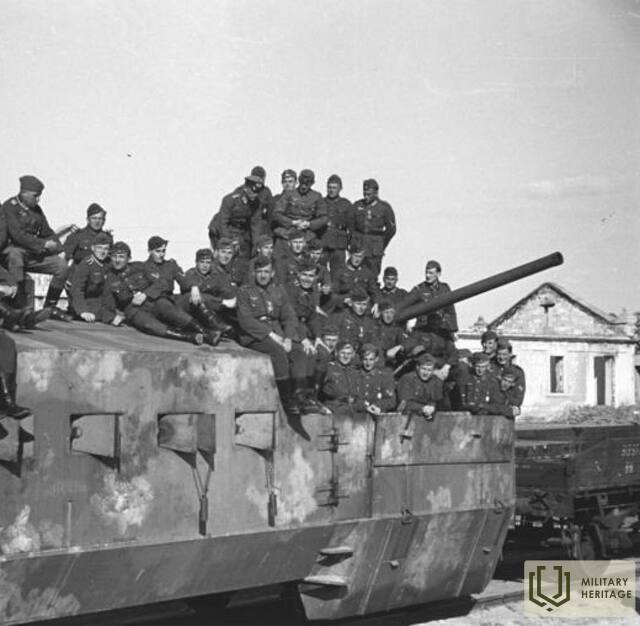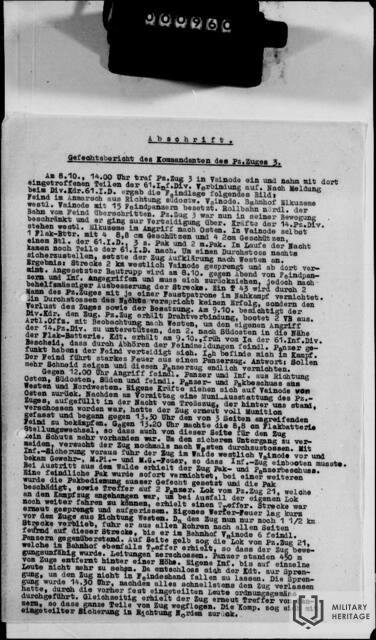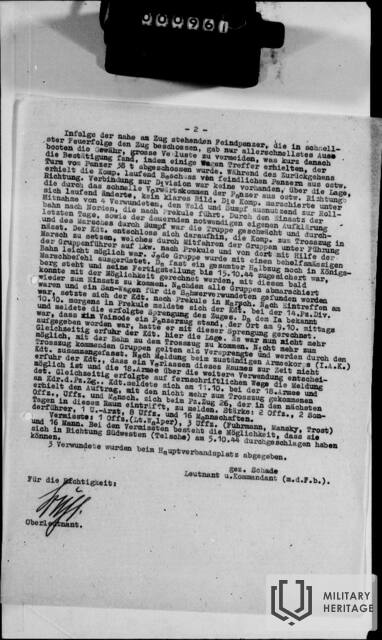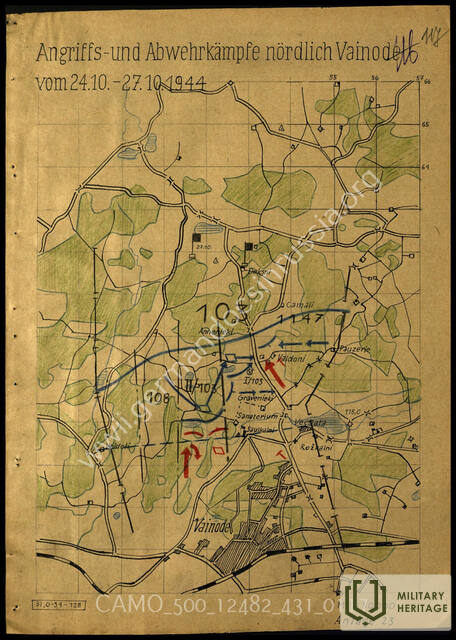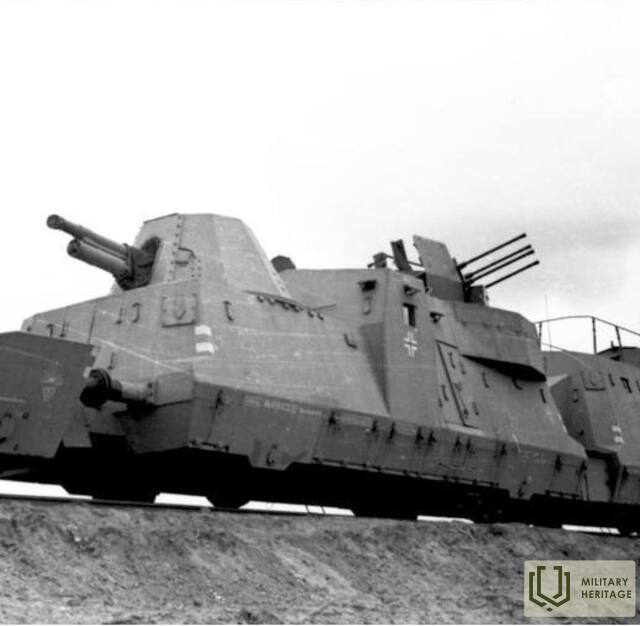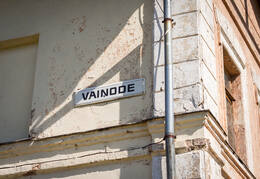The last battle of the German Army's 3rd armored train at Vaiņode Station
In October 1944, the German army retreats. The 3rd armoured train arrives at Vaiņode station.
As a result of the collapse of the German front, only small units of the German 61st Infantry Division, supported by the armoured train, were present in the eastern outskirts of Vaiņode. The resistance was quickly overcome and by the evening of 9 October the whole of Vaiņode was under the complete control of the Red Army.
The report of the commander of the German army armoured train No.3 reflects the intense events of those days and the loss of armoured train No.3.
On October 8, 1944, armored train No. 3 arrived in Vaiņode and established contact with units of the 61st Infantry Division, which had also arrived. According to the information of the chief of staff of the 61st Infantry Division, the enemy positions were as follows:
The enemy is approaching Vaiņode from the southeast. Elkuzeme station west of Vaiņode has been occupied by 15 enemy tanks. The highway north of the station has been crossed by the enemy. Armored train No. 3 now had limited movement capabilities, so it took up defensive positions. The 14th Panzer Division is located in the western part of Elkuzeme and is going to attack in an eastern direction. In Vaiņode itself, there is one battery with four 8.8 cm anti-tank and anti-aircraft artillery guns and four 2 cm guns, one battalion of the 61st Infantry Division, three heavy and two medium anti-tank guns. Additional units of the 61st Infantry Division arrived during the night. The train began reconnaissance of the area to the west in order to ensure a breakthrough from the enemy encirclement in the western direction at night. As a result, it is established: The tracks 2km west of Vaiņode have been blown up and mined from there. On the evening of October 8, the involved construction unit is attacked by enemy tanks and infantry and retreats, however, completing some track improvement work as much as possible. Two armored train crew members destroy one T34 tank in close combat with an anti-tank grenade launcher (Panzerfaust). The breakout attempt at night appears to be unsuccessful, with the subsequent loss of the armored train and its crew. On the morning of October 9, the division commander inspects the train. Communication cables are pulled to the armored train, two forward observers (2 VB) are deployed. One artillery officer with observation capabilities to the west to support the 14th Tank Division's attack, the second - to the southeast near the battery. Early in the morning of October 9, the commandant receives information from the chief of staff of the 61st Infantry Division that a radio message from enemy tanks has been intercepted: “The enemy is defending. I am in battle. The enemy has opened fire from an armored train. Response: Show heroism and finally destroy that armored train.”
Around 12:00, the enemy tanks and infantry attack begins from the east, southeast, south, and enemy tank and anti-tank gun fire from the west and northwest. Our troops retreat from the east back to Vainodi. After one of the armored train's ammunition depots was fired on in the morning, which had been filled during the night from the supply train (Trosszug), which was standing directly behind the armored train. The armored train's supplies were completely restored and around 13:30 it began to fight the enemy attacking from three sides. Around 13:20, the battery changed its position so that the train no longer had cover from that side. To prevent certain destruction, the train tries to break out to the West again. With an infantry unit at the forefront, the armored train went into the forest west of Vainode and received rifle, machine gun and machine gun fire, so that the infantry unit had to move back. Leaving the cover of the forest, the train was fired upon by anti-tank guns and tanks. One enemy gun was immediately destroyed, another gun crew was completely destroyed and the gun was damaged, and two enemy tanks were hit. The enemy also hit the locomotive of the 21st armored train, which was hitched to the train in case the real locomotive was damaged. The tracks were once again blown up and torn. The mortar fire from the west hit the train very close. Since the train had only 1.5 km of track left, it headed towards Vainode station, firing from all possible weapons in all directions, where it was confronted by six enemy tanks at the station. The locomotive of the 21st armored train also received a direct hit at the station, and thus the train lost its ability to move, as its technical lines had been shot. The tanks were 450 m away behind a hill. Its infantrymen were no longer visible, except for a few. At this moment, the train commander made the decision to blow up the train so that it would not fall into enemy hands. After everything possible was evacuated from the train, specially assigned people carried out the train explosion at 14:30. At the same time, the train was also hit by tank shells, so that parts of the train flew in all directions. The train crew retreated northward.
Since enemy tanks were in close proximity and were constantly firing at the train, the only way out was to abandon the train as soon as possible to avoid huge losses. This was confirmed by the fact that several carriages received direct hits and the turret of the 38(t) tank was torn off. While retreating, the train crew was continuously fired upon by tanks from the east. There was no communication with the division and it was unclear about the situation, which was constantly changing. The crew with four wounded men went through swamps and forests to the highway in the north towards Priekule. Taking into account the events of the last few days, the continuous reconnaissance and the retreat through the swamps, the group was weakened and soaked. The commander's goal was to deliver his crew to Priekule and wait for half of the armored train from Königsberg on October 15, in order to go into battle with it again. Arriving in Priekule on October 10, the armored train commander informs about the bombing of the armored train and learns that it is no longer possible to reach the supply train by rail and it is impossible to leave this area. On October 11, the commandant received an order from the command of the German 18th Army to arrive with personnel in the 26th armored train. Composition: 2 officers, 2 specialists, 1 medic, 8 instructors and 16 men.
Missing: 1 officer (Lieutenant Walper), 3 instructors (Fuhrmann, Mansky, Trost) and 16 men. It is possible that the missing broke out southwest towards Telšiai on October 5. The 3 wounded were transferred to the main dressing station.
Signed by Schade – Lieutenant and Commandant
NARA Archives - Transcript of a report from the commandant of German Army Armored Train No. 3 (translated from German)
Related timeline
Related objects
Vaiņode station
The railway station building was opened with the construction of the Liepāja-Vainode railway line in 1871. The station building itself was opened in 1872. This was also the beginning of a great activity in the development of the central streets of Vaiņode. It is significant that in the guidebooks of the time, the distance of each building or object was indicated as the distance from the railway station. The railway station was once an important military transport hub.
During the First World War, a branch line was built from the station to the airfield, which brought materials (metal shapes for hangars), cranes, winches and ammunition for war stores, which were then transported by zeppelins to Riga and bombed the Russian fortifications.
The railway station building was not affected by the devastation of World War II and has not changed its appearance over time. Vaiņode station can be seen from the outside.
The military activity in the vicinity of Vaiņode can be traced back to the successful Red Army offensive that began on 5 October 1944 in the vicinity of Šiauliai. Quickly crushing the weak German resistance, Soviet tank units were tasked with seizing the strategically important Liepāja-Shaul railway line. In the early hours of 9 October 1944, the first units of the 79th Tank Brigade of the 19th Panzer Corps and the separate units of the 143rd Tank Brigade launched an offensive. As a result of the collapse of the German front, only small units of the German 61st Infantry Division, supported by armoured trains, were present in the eastern outskirts of Vaiņode. The resistance was quickly overcome and by the evening of 9 October the whole of Vaiņode was under the complete control of the Red Army. On 10 October, units of the 103rd Rifle Corps of the Soviet 6th Guards Army arrived and continued their attacks, pushing back the German 61st Infantry Division 2 km north of the Skaistkalne sanatorium. As the Soviet forces took Vaiņode with little fighting, the Vaiņode station and the town's buildings suffered relatively little.
The fighting got a little closer to Vaiņode on 24 October 1944, when the German 10th Corps, with the 14th Panzer Division in the lead, carried out an offensive operation nicknamed "Eberhard". During the fighting, the front line consolidated just north of the sanatorium and remained there until 27 October, when the Red Army launched an offensive known as the 1st Kurland Bolshoi.




